Germany faced its horrible past. Can we do the same?
By Michele L. Norris, The Washington Post —
Shortly after the National Museum of African American History and Culture opened in 2016 on the National Mall, I was speaking to some patrons of a successful nonprofit about the importance of candid racial dialogue in politics and in the places we live, work and worship.
One of the participants had recently toured the museum and had a pointed question. Why, she wondered, were all the exhibits that visitors first encounter dedicated to slavery? Among other things, she was referring to a reconstructed cabin built by former slaves from Maryland and a statue of Thomas Jefferson next to a wall with the names of more than 600 people he owned. “Couldn’t the exhibits begin with more uplift?” the woman asked, arguing that Black achievement was more worthy of the spotlight. She suggested that the museum should instead usher visitors toward more positive stories right from the start, so that if someone were tired or short on time, “slavery could be optional.”
Her question was irksome, but it did not surprise me. I’d heard versions of the “Can’t we skip past slavery” question countless times before. Each time serves as another reminder that America has never had a comprehensive and widely embraced national examination of slavery and its lasting impact. Yes, there are localized efforts. But despite the centrality of slavery in our history, it is not central to the American narrative in our monuments, history books, anthems and folklore.
There is a simple reason: The United States does not yet have the stomach to look over its shoulder and stare directly at the evil on which this great country stands. That is why slavery is not well taught in our schools. That is why the battle flag of the army that tried to divide and conquer our country is still manufactured, sold and displayed with defiant pride. That is why any mention of slavery is rendered as the shameful act of a smattering of Southern plantation owners and not a sprawling economic and social framework with tentacles that stamped almost every aspect of American life.
We can read about, watch and praise documentaries and Hollywood projects about the Civil War, or read countless volumes on the abolitionist or civil rights movements. But these are all at a remove from the central horror of enslavement itself. From the kidnappings in Africa to the horrors of the Middle Passage, the beatings and the instruments of bondage, the separation of families, the culture of rape, the abuse of children, the diabolical rationalizations and crimes against humanity — no, we haven’t had that conversation. We have not had that unflinching assessment, and we are long overdue.
America experienced 246 years of slavery before it was officially ended with the passage of the 13th Amendment. That was followed by decades of legal segregation and oppression under Jim Crow, followed by a period of willful blindness and denial. A tourist from a foreign land might well conclude that the Confederacy had actually won the Civil War, based on the number of monuments, buildings and boulevards still named for heroes of its defeated army. The real truth of our shared history was a casualty of that war and, like any wound left untended, the results can be catastrophic.
A full accounting of slavery is one of terror and trauma, and for decades the natural inclination was to ask, why would anyone want to claim that history? But at a moment when the United States is dangerously divided, when we are having bitter and overdue conversations about policing, inequality and voting rights, when marauders fueled by white-nationalist rhetoric can overwhelm the Capitol, proudly waving the Confederate battle flag, the more important question is this: What happens if we don’t?
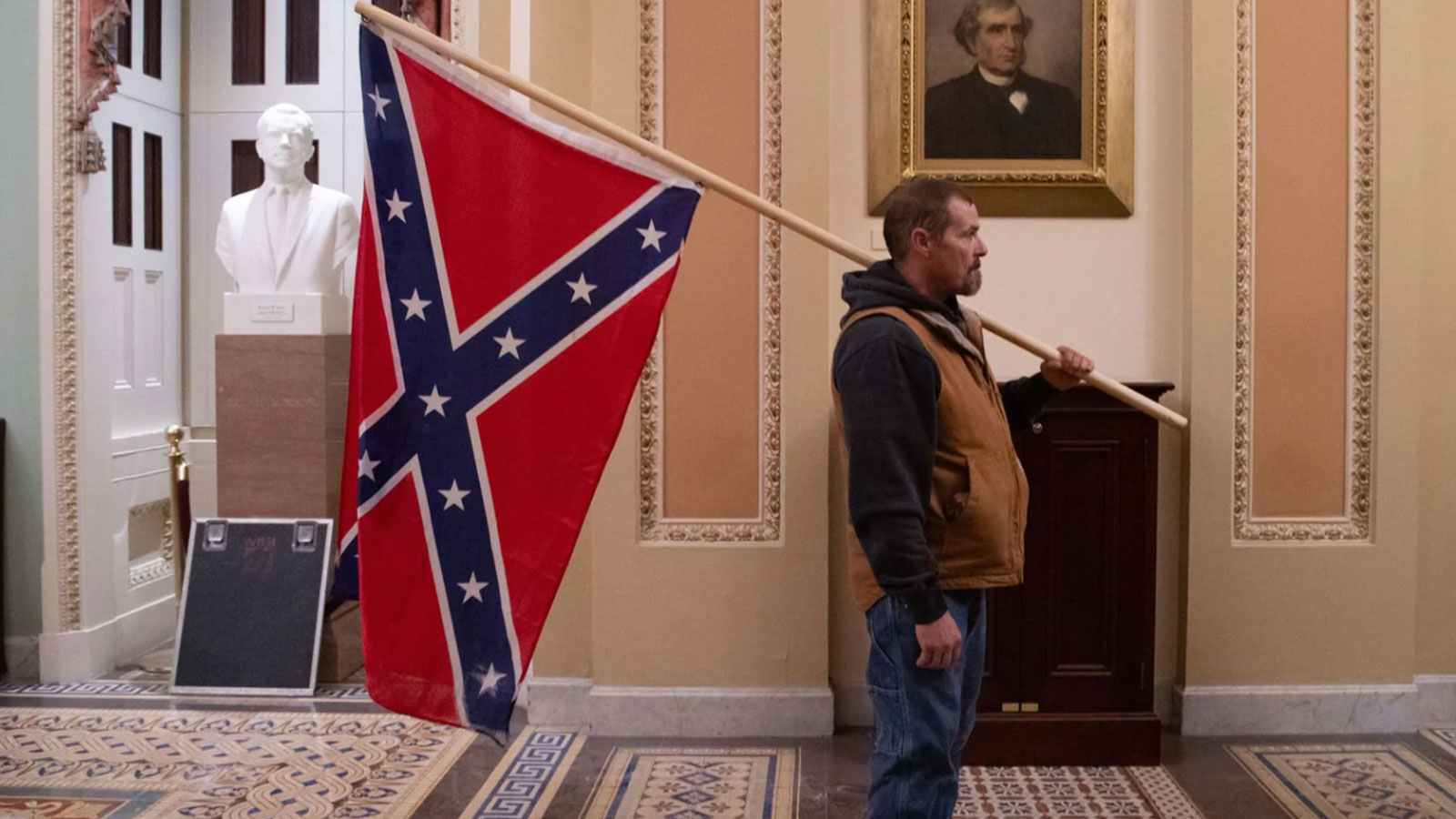
A supporter of then-President Donald Trump holds a Confederate battle flag outside the Senate chamber during rioting inside the U.S. Capitol on Jan. 6, 2021. (Saul Loeb, AFP via Getty Images)
Historians often look to “collective memory” — how groups of people typically recall past events — to help decipher a nation’s identity and soul. These memories can change over time, and there is evidence that people remember things that never happened. But collective forgetting can be just as revealing.
The United States is not the only country with an evil antecedent that was swept aside, forgotten or minimally examined. That list is long, but one country offers a powerful alternative path. Barely three generations ago, Germany hosted horrors that killed millions and left the nation split in two. This was not a legacy that most Germans were inclined to honor. And yet, today, less than 100 years after the rise of Adolf Hitler, Germany has made a prodigious effort to come to terms with its past with regularized rituals of repentance and understanding.
This collective culture of atonement is captured in the eight syllables and 26 letters that comprise the German word Vergangenheitsaufarbeitung. It’s a mouthful that translates loosely to “working off the past.” But its full meaning goes deeper than even that awkward phrase suggests.
Vergangenheitsaufarbeitung refers to Germany’s efforts to interrogate the horrors of the Holocaust and the rise of Nazism. It has been a decades-long exercise, beginning in the 1960s, to examine, analyze and ultimately learn to live with an evil chapter through monuments, teachings, art, architecture, protocols and public policy. The country looks at its Nazi past by consistently, almost obsessively, memorializing the victims of that murderous era, so much so that it is now a central feature of the nation’s cultural landscape. The ethos of this campaign is “never forget.”
This collective culture of atonement is captured in the eight syllables and 26 letters that comprise the German word: Vergangenheitsaufarbeitung. It’s a mouthful that translates loosely to “working off the past.” But its full meaning goes deeper than even that awkward phrase suggests.
“There isn’t a native equivalent for this word in any other language, and while many countries have in one way or another tried to confront past evils, few if any have done what Germany has done,” said Susan Neiman, a moral philosopher at Berlin’s Einstein Forum who has long studied the social aftermath of the war in Germany. An American Jew raised in Atlanta, Neiman has spent most of her adult life in Germany and is the author of a book about the inquiry: “Learning from the Germans: Race and the Memory of Evil.”
“They got right the idea that a nation has to face its criminal past in order to become whole and strong and not riven by unsaid guilt, unsaid resentment,” she explained. “They got right the idea that here is a process that one can go through that it takes time, but that you come out better in the end. And they got right the idea that it has to happen on several fronts.”
What ushered in the era of Vergangenheitsaufarbeitung? There is no singular hero or postwar epiphany you can find in the history books. Germany came to it slowly and, it must be said, reluctantly. And it took a different generation born long after Germany’s surrender to stoke the idea. It is important to remember that Germany did not immediately reach for atonement after World War II. Former servants of the Reich drifted back into government. And even with the Allies’ strict protocol of war crimes trials and denazification — a process that at the time was often called “victor’s justice” — Germans often cast themselves as victims in the decades immediately following World War II.
The televised 1961 trial in Israel of Adolf Eichmann, a chief architect of the Holocaust, and the Auschwitz trials of former Nazi war criminals from 1963 to 1965, began to alter that view. The two tribunals awakened public interest in the previous generation’s horrifying immorality. The Auschwitz tribunal was billed as the “trial of the century” in Europe, and it stirred an appetite for a deeper explanation of what happened between 1930 and 1945. It also sparked questions about why so many everyday Germans willingly marched along that dark path.
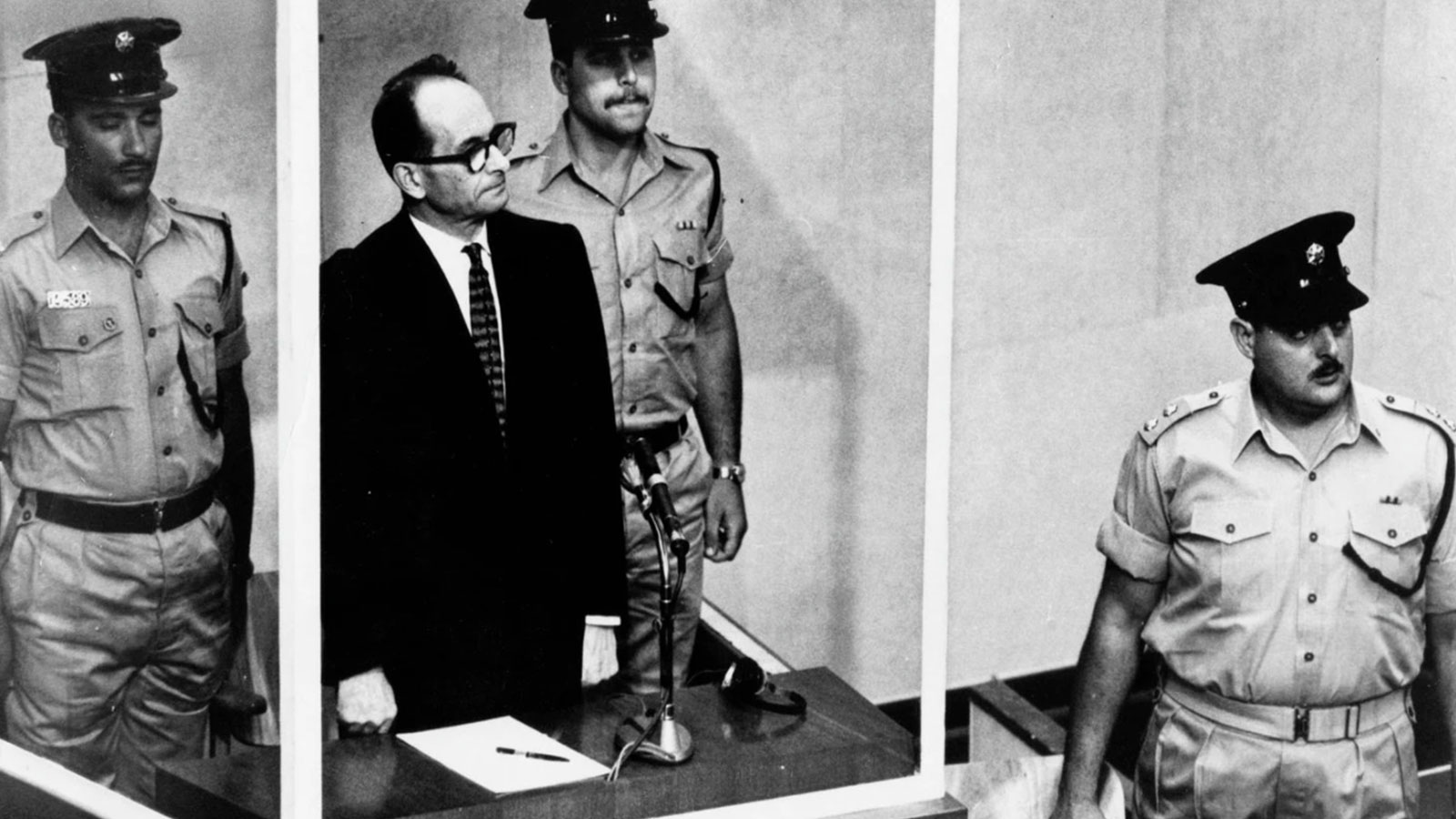
This 1961 photograph shows Adolf Eichmann standing in his glass cage, flanked by guards, in a Jerusalem courtroom during his trial for war crimes committed during World War II. (AP)
The trials culminated in a period when the world was entering an era of protest and social unrest as postwar baby boomers agitated for a new guiding sensibility. Unsettling questions about the country’s past also reverberated in private homes as children raised by people who had survived the war demanded a greater accounting of their relatives’ roles. Were the people at their kitchen table, at the desk in front of their classroom, at the cash register at the corner bakery connected to the atrocities described in those televised trials? And the questions raised by those real-life courtroom dramas created an urgency among historians, artists and government officials to research what happened while simultaneously looking for a path toward acceptance and respectability.
By the mid-1960s, West Germany’s economy was beginning to hum, but the country still carried the stench of history. Would anyone in the world buy those affordable little rear-engine Volkswagen Beetles if they came from a place that was indelibly branded with hatred and genocide? “As Germany got to be a little bit wealthier and people began to be able to travel within Europe,” Neiman said, “young people did start hearing the other side of the story, not just, poor us, we lost the war. They realized how uncomfortable it was to be a German visitor in France or in Holland or elsewhere in Europe. Vergangenheitsaufarbeitung came into use in the ‘60s, an abstract, polysyllabic way of saying, ‘We have to do something about the Nazis.’”

An employee at a Volkswagen factory inspects a Volkswagen 1200 Sedan, better known as a Beetle, on the assembly line in Wolfsburg, then in West Germany, in the 1960s. (Pictorial Parade/Getty Images)
A good deal of the energy that fueled the rise of Vergangenheitsaufarbeitung happened at the grass roots with individuals changing the landscape by literally putting their hands in the soil, digging up the weeds that had grown over abandoned concentration camps and unearthing underground Gestapo torture chambers in the middle of Berlin.
In today’s Germany, children learn through their teachers and textbooks that the Nazi reign was a horrible and shameful chapter in the nation’s past. Cadets training to become police officers in Berlin take 2½ years of training that includes Holocaust history and a field trip to the Sachsenhausen concentration camp. With a few exceptions for the sake of education, it is against the law to produce, distribute or display any symbol of the Nazi era, including the swastika, the Nazi flag and the Hitler salute. It is also illegal to deny that the Holocaust was real.
Instead, memorials of remembrance are ubiquitous and honor the vast array of victims of the Nazi regime: Jews, gays, Roma, the disabled and those who were viewed as disrespectable, anti-social or traitors. Some of the monuments are impossible to miss; others catch you by surprise. Many do both: The Memorial to the Murdered Jews of Europe covers 4.5 acres in the heart of downtown Berlin, prime real estate set aside by parliament when the Berlin Wall came down — despite a long line of real estate interests that were eager to develop the property. The former Neuengamme internment camp in Hamburg features a sculpture of a twisted, bald and naked human form that conveys the soul-crushing history and the backbreaking work of camp prisoners in a brick factory. If one looks down into a large glass oculus cut into the pavement at Berlin’s Bebelplatz square, you will see a sunken library — featuring rows of empty white shelves that symbolize the thousands of books burned by Nazis. A bronze marker bears the inscription: “That was but a prelude; where they burn books, they will ultimately burn people as well.”
Many, if not most, of the memorials are far more subtle. Plaques and markers in many German cities note the locations of synagogues, schools and Jewish neighborhoods that were raided and razed by Hitler and his legions. Roughly 75,000 small brass “stumbling stones,” known as Stolpersteine, are embedded in the streets and plazas of hundreds of towns and cities throughout Germany and elsewhere. Each begins with the phrase “Here lived” and is followed by the facts of someone’s life — their name and birth date. And then that etching is followed by the grim facts of their fate: exile, internment, murder.

A visitor walks through the Holocaust Memorial or Memorial to the Murdered Jews of Europe in Berlin on Sept. 20, 2018.

Memorial for the victims in the former Neuengamme concentration camp.
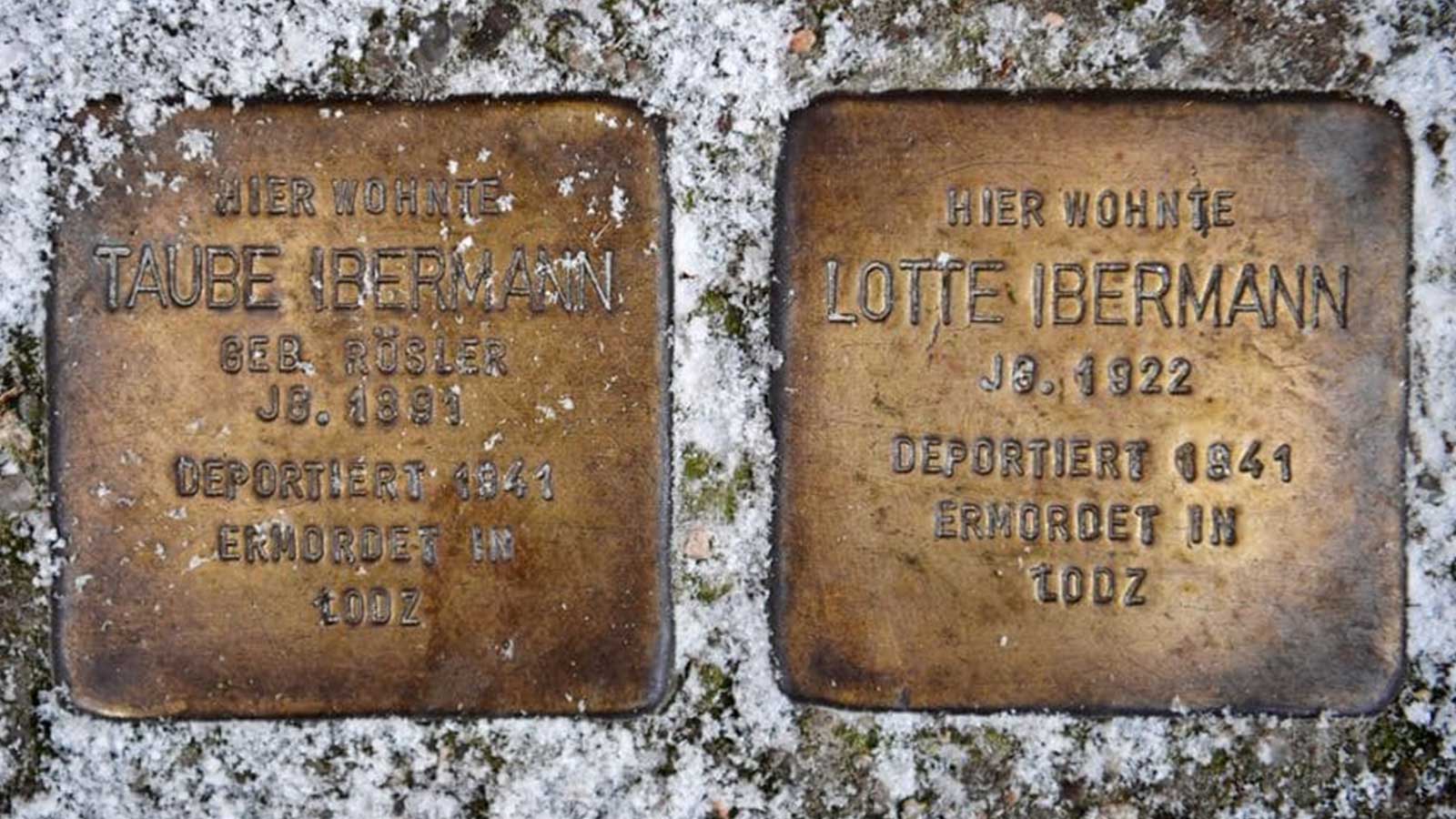
Two Stolpersteine (stumbling blocks) commemorating Holocaust victims, are pictured in front of Fehrbellinerstrasse 86 in Berlin on Jan. 5, 2017. The small plaques the size of a child’s hand document the fate of a mother and daughter who lived in a small apartment: 50-year-old Taube Ibermann and Lotte, 19.
Imagine traveling through an American state and coming upon small, embedded memorials that listed key facts about the lives of the enslaved. Their names. Their fates. Their birth dates. The number of times they were sold. The ways they were separated from their families. The conditions of their toil. Imagine how that might shape the way we comprehend the peculiar institution of slavery, its legacy and its normalized trauma. Imagine if there were similar embedded memorials for Indigenous peoples, who were forced from their land, relegated to reservations far from their normal ranges and regions. Imagine stopping to fill up the tank at a roadside gas station and noticing the reflection off a gleaming brass marker that bears the names of the tribal elders who once lived where you are standing.
I am not suggesting that slavery and the Holocaust or the forced removal of Native American peoples are all in the same vein. They are each distinctly diabolical. But comparing these two countries’ paths forward from a dark past is instructive because it sheds light not on comparative evil but instead contrasting redemption. The United States helped dictate the terms of Germany’s future after the war. In the decades after that, Germany outpaced the United States in coming to terms with a shameful past that collided with the country’s preferred narrative.
By the time West German President Richard von Weizsäcker delivered a speech marking the 40th anniversary of the end of World War II in May 1985, the landscape had already shifted. Weizsäcker, then 65, was a leader in the center-right Christian Democratic Union, a former Wehrmacht captain whose father was the chief career diplomat for the Third Reich. And yet, there he was, gray-haired and solemn before the Bundestag, shifting the conventional narrative by asking his country to reconsider and remember the true nature of the nation’s past: “We need to look truth straight in the eye.”
“The young and old generations,” he said, “can and must help each other to understand why it is important to keep memories alive. It is not a case of coming to terms with the past. That is not possible. It cannot be subsequently modified or made undone. However, anyone who closes his eyes to the past is blind to the present. Whoever refuses to remember the inhumanity is prone to new risk of infection.”
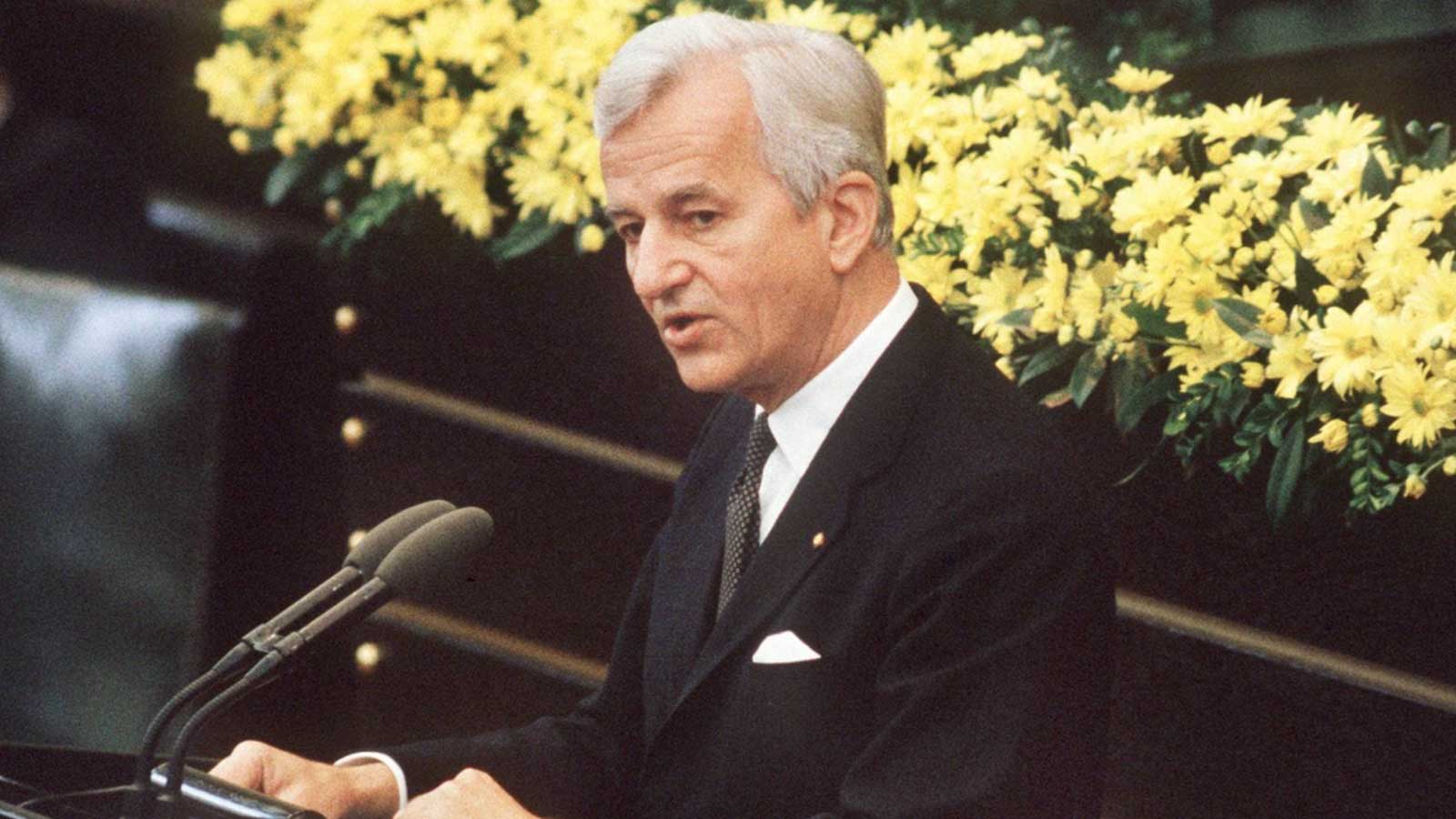
Richard von Weizsäcker. Credit: picture alliance via Getty Image
Anyone who closes his eyes to the past is blind to the present. Whoever refuses to remember the inhumanity is prone to new risk of infection. — Richard von Weizsäcker, President of West Germany, in 1985 marking the 40th anniversary of the end of World War II
Those words should reverberate and haunt us today in America, where a resurgent wave of white nationalism is widely visible. At a time when America’s political parties are at war over the teaching of critical race theory in schools, it is hard to see how our governing leadership could possibly reach consensus about acknowledging and examining the horrors of slavery. Could someone in the conservative camp challenge the party’s prevailing ideology and demonstrate the introspective courage shown by Weizsäcker? I wish the answer were yes.
Yet it is important to remember that Germany’s path to truth was not swift or easy. It was halting and imperfect, and efforts to make reparation were awkward and meager. While there are now thousands of memorials across Germany, not all of them strike the right note, and debate continues as to how to provide something in the way of balm to families who still contend with public shame and private grief for loved ones lost in the war. And Germany is better at acknowledging its crimes in its big cities than in smaller towns far from the capital.
Nor has Vergangenheitsaufarbeitung been able to fully extinguish the forces of racial and ethnic hatred inside Germany. The country’s police and security agencies have been plagued by far-right extremism in the ranks and, as in many parts of the world, a strong anti-immigrant bias has taken root in activist groups. “The most thoughtful Germans, East and West, are reluctant to praise German Vergangenheitsaufarbeitung,” notes Neiman. “They are too aware of its flaws.”
But if Germany’s reckoning with its Nazi past is a sprawling, complicated, messy, ongoing process, it is an active process. And because of that, its national compass remains pointed toward a more just and humane future. Our compass for charting a new course from a difficult history is shaky, and we should just admit that as we begin our own journey toward truth.
When Barack Obama was first elected president in 2008, there was an expectation that he would lead some kind of national conversation about race. We don’t place the same expectations on White leaders for some reason, but we should.President Biden was in Tulsa to mark the 100-year anniversary of one of the most vicious acts of racial violence in U.S. history. In 1921, an angry White mob attacked a thriving Black community known as “Black Wall Street.” A 35-block stretch of homes, churches and prosperous businesses was ransacked and burned; as many as 300 people died. Until recently, the Tulsa Race Massacre was missing from history books and rarely discussed. Biden met with survivors who were children when that terror was unleashed, and he spoke directly about white supremacy in a way few presidents have. “We should know the good, the bad, everything,” he said. “That’s what great nations do: They come to terms with their dark sides. And we’re a great nation.”
That is a start. Biden should keep his foot on that pedal and launch an official inquiry about uncomfortable historical truths, and do it in a way that ensures that it will extend over years, if not decades. Because it is time for the United States to convene its own version of a truth and reconciliation commission and fully examine the horrors of slavery and their continued aftermath. And it is time to do this with the full expectation that many Republicans will cry foul, howl at the fringes and try to undermine every aspect of the exercise.
That should not stop the effort. That is the very reason the collective American narrative needs a strong dose of truth. We need clear eyes and a firm spine, and then we need to chart a new path forward. That kind of step would also launch re-examinations of the treatment of America’s Indigenous peoples, the eugenics movement and the internment camps of the 1940s for U.S. citizens and noncitizens of Japanese descent.
And yet we are in a moment when hard truths are not just inconvenient, they are challenged and dismissed with great fanfare. A growing cottage industry is taking root among those who use their animus to stoke the fires of white grievance and feed the false claim that the hidden motive of all truth-seeking is to elevate people of color by making White people feel bad about themselves.
Anyone who closes his eyes to the past is blind to the present. Whoever refuses to remember the inhumanity is prone to new risk of infection.
Richard von Weizsäcker, President of West Germany, in 1985 marking the 40th anniversary of the end of World War II
Those words should reverberate and haunt us today in America, where a resurgent wave of white nationalism is widely visible. At a time when America’s political parties are at war over the teaching of critical race theory in schools, it is hard to see how our governing leadership could possibly reach consensus about acknowledging and examining the horrors of slavery. Could someone in the conservative camp challenge the party’s prevailing ideology and demonstrate the introspective courage shown by Weizsäcker? I wish the answer were yes.
Yet it is important to remember that Germany’s path to truth was not swift or easy. It was halting and imperfect, and efforts to make reparation were awkward and meager. While there are now thousands of memorials across Germany, not all of them strike the right note, and debate continues as to how to provide something in the way of balm to families who still contend with public shame and private grief for loved ones lost in the war. And Germany is better at acknowledging its crimes in its big cities than in smaller towns far from the capital.
Nor has Vergangenheitsaufarbeitung been able to fully extinguish the forces of racial and ethnic hatred inside Germany. The country’s police and security agencies have been plagued by far-right extremism in the ranks and, as in many parts of the world, a strong anti-immigrant bias has taken root in activist groups. “The most thoughtful Germans, East and West, are reluctant to praise German Vergangenheitsaufarbeitung,” notes Neiman. “They are too aware of its flaws.”
But if Germany’s reckoning with its Nazi past is a sprawling, complicated, messy, ongoing process, it is an active process. And because of that, its national compass remains pointed toward a more just and humane future. Our compass for charting a new course from a difficult history is shaky, and we should just admit that as we begin our own journey toward truth.
When Barack Obama was first elected president in 2008, there was an expectation that he would lead some kind of national conversation about race. We don’t place the same expectations on White leaders for some reason, but we should.President Biden was in Tulsa to mark the 100-year anniversary of one of the most vicious acts of racial violence in U.S. history. In 1921, an angry White mob attacked a thriving Black community known as “Black Wall Street.” A 35-block stretch of homes, churches and prosperous businesses was ransacked and burned; as many as 300 people died. Until recently, the Tulsa Race Massacre was missing from history books and rarely discussed. Biden met with survivors who were children when that terror was unleashed, and he spoke directly about white supremacy in a way few presidents have. “We should know the good, the bad, everything,” he said. “That’s what great nations do: They come to terms with their dark sides. And we’re a great nation.”
That is a start. Biden should keep his foot on that pedal and launch an official inquiry about uncomfortable historical truths, and do it in a way that ensures that it will extend over years, if not decades. Because it is time for the United States to convene its own version of a truth and reconciliation commission and fully examine the horrors of slavery and their continued aftermath. And it is time to do this with the full expectation that many Republicans will cry foul, howl at the fringes and try to undermine every aspect of the exercise.
That should not stop the effort. That is the very reason the collective American narrative needs a strong dose of truth. We need clear eyes and a firm spine, and then we need to chart a new path forward. That kind of step would also launch re-examinations of the treatment of America’s Indigenous peoples, the eugenics movement and the internment camps of the 1940s for U.S. citizens and noncitizens of Japanese descent.
And yet we are in a moment when hard truths are not just inconvenient, they are challenged and dismissed with great fanfare. A growing cottage industry is taking root among those who use their animus to stoke the fires of white grievance and feed the false claim that the hidden motive of all truth-seeking is to elevate people of color by making White people feel bad about themselves.
It is not surprising that some White people would be reluctant to dive into this history. We are still producing textbooks where the enslaved are called “workers of Africa.” And while racial fatigue is a real thing leading to real tensions and discomfort, it sometimes seems that people claim to be exhausted by a conversation that has never really taken place. I wonder whether people are just repelled by the idea of this conversation or they are really rattled by what they might hear.
I also find it deeply ironic that there is such a fierce battle to evade and erase historical teachings about slavery because, in the time of enslavement, there was such an assiduous effort to document and catalogue every aspect of that institution, much in the way people now itemize, assess and insure their valuables. The height, weight, skin color, teeth, hair texture, work habits and scars that might help identify anyone who dared flee were documented. Their teeth, their work habits, their menstrual cycles and their windows of fertility — because producing more enslaved people produced more wealth — were entered like debits and credits in enslavers’ ledgers.
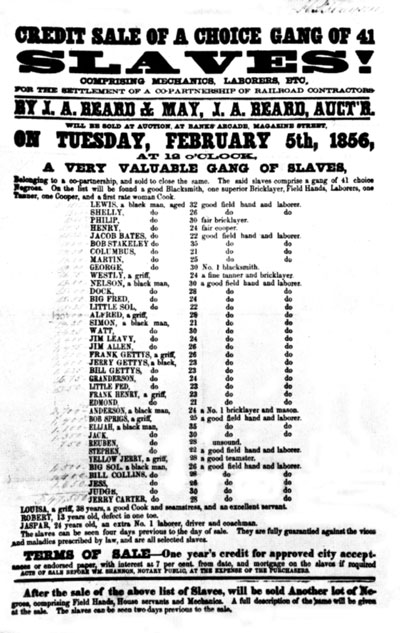
Poster announcing a slave sale in 1856. (Photo 12/Universal Images Group via Getty)
A startling example comes from Daina Ramey Berry, professor and chair of the history department at the University of Texas at Austin and the author of “The Price for Their Pound of Flesh.” Berry compares the sale of two “first rate prime males” named Guy and Andrew sold in 1859 at what was believed to be the largest auction in U.S. history. They were the same age and size and had similar skills. Andrew sold for $1,040, while Guy elicited a larger sum of $1,280. The difference was that Andrew had lost a right eye. A newspaper reporter covering that two-day auction in 1859 noted that the value of a Black man’s right eye in the South was $240.
Amnesia gets in the way of atonement in America. But amnesia is actually too benign a word because it sounds as though people just forgot about the horrors of slavery, forgot about people who were forced to work in the fields literally until their death, forgot that more than 2 million Africans died during their forced migration to this country in the way one forgets where they placed their car keys or their passport.
We’ve been through more than a willful forgetting; we’ve had instead an assiduous effort to rewrite history. We’ve built monuments to traitors and raised large sums of money to place the names of generals who fought against their own country all over highways and civic buildings. We’ve allowed turncoats to become heroes of the Lost Cause instead of rebels desperate to keep people in bondage.
On a personal level, this false narrative about America is another act of cruelty, even a kind of larceny. I view the real story, the genuine history — ugly as it is — as part of my people’s wealth. You built this country on the backs of African Americans’ ancestors. Our contributions — in blood, sweat and bondage — must be told. Our children, indeed, all of America, deserve to know what we have endured and survived to understand the depth of our fortitude, but also to understand that, despite centuries of enslavement and years of Black Codes and brutal Jim Crow segregation, our contributions are central to America’s might. The erasure is massive in scope.
Our inability to face this history is a stick in the wheel of forward progress, a malignancy that feeds the returning ghost of white supremacy, a deficit that paves the way for bias to return. We find ourselves pulled backward in time, reliving some of the same challenges that inspired the civil rights movement 60 years ago — restrictions on voting rights, police assaults on Black bodies, racial disparities in almost everything pandemic-related, from deaths and infection rates to access to vaccines.
We know the countries that combine truth and resolve have the best chance to reconcile with a difficult past. Truth is the most important ingredient, and it carries a special currency after four years of an administration that peddled falsehoods without apology and continues to use a series of big lies to justify a war on our democracy. It is long past time to face where truth can take us.
Pride is part of our brand in America. So, too, is strength. Shame doesn’t fit easily into that story. The Germans decided that discomfort could make them stronger by creating guardrails against a returning evil. We instead have reached for blinders.
There is no equivalent concept for Vergangenheitsaufarbeitung in our culture. It doesn’t even translate well into English. One might be tempted to think of it as working to shed the past — as in dropping pounds or paying a debt. But it really means something more prospective, like trying to build an ever bigger, ever more complicated structure off a foundation with serious cracks. Those flaws must be addressed, assessed, fixed and made sturdy before the foundation can take more weight.
To address something this monumental we often look to our biggest institutions to lead the way. But if we are to actually learn from the Germans, we have to widen our aperture. Yes, we will need leaders who have the courage to face this history to use their platforms and their muscle in government, business, religion, philanthropy and academia. But the reason Vergangenheitsaufarbeitungtook root in Germany was because its most ardent and committed proponents were closer to the ground. It wasn’t limited to the ivory tower, the C-suite or the pulpit. History was challenged from below.
Take the stumbling stones: The stories are researched by neighbors, schoolchildren, and church or civic groups. They raise the money and track down the victim’s relatives, and as protocol dictates, invite them to a modest installation ceremony. These small acts of atonement and grace led to a national willingness to confront an odious history.
Could we ever open our eyes here in the United States to confront the lies in our founding myths? Could we comprehend the strength that comes from learning the real story? Do we have the fortitude for a reckoning that goes so much deeper than placing a Black Lives Matter sign in the front yard or insisting that fidelity to the Confederate flag is really about honoring Southern heritage instead of an institution based in hatred? Can we hope to produce a generation of leaders who can speak and be heard and perhaps even embraced by people who occupy those opposing terrains? Our future as a united country of people ever more divided depends on it.
When I first learned about Vergangenheitsaufarbeitung, I kept thinking about the encounter I had with the woman who had asked me if “slavery could be optional” within a museum dedicated to Black life in America. She wanted it swept from the story like an unsavory item on a menu: I’ll take a serving of patriotic history, but please hold the whippings and the bondage.
But, no, slavery cannot be an optional part of the national story. It should not be excised from the narrative we teach our children about who we are and what we have become.
We must admit to, examine, reflect, lean into and grow through that history. All of that history.
What is the word for Vergangenheitsaufarbeitung in English?
We must find it.
Source: The Washington Post
Featured Image by Brian Stauffer for The Washington Post.















